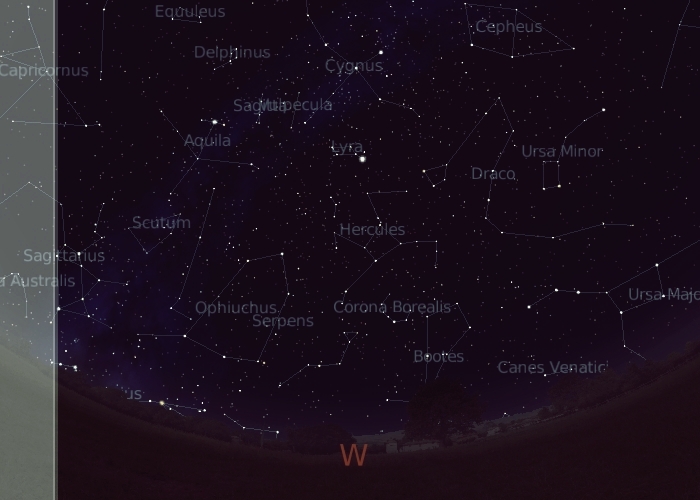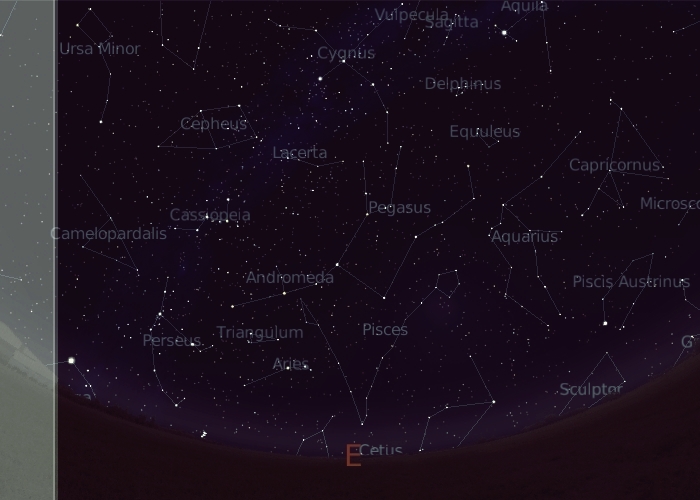|
back
September, Mid-Northern Latitudes (September 15th, 10:30 p.m. local time)

Western Horizon
Eastern Horizon

It's the summer's end! The autumnal equinox is occurring this month however, thus bringing to a sky which begins to be a transitional one! The Summer Triangle, this distinctive feature of our summer nights, keeps being high, southwest. The Summer Triangle, like the name, is a vast triangle composed by three bright stars -the three main stars to the constellations Cygnus, the Swan, Lyra, the Lyra, and Aquila, the Eagle. The highest of those three spikes, South, at the zenith, is Deneb, of Cygnus. Beneath, lower, it's Vega, of Lyra, as lower too, the third spike is Altair, of Aquila! Small, fine constellations, high, South, are associated with the Summer Triangle, like Delphinus, the Dolphin, Equuleus or the Little Horse. scorpius, the Scorpion, and Sagittarius, the Archer, has now shifted southwest, tending to the horizon. South further, it's the best time for Capricornus, the Goat. Let's be back West! As Arcturus, a bright star, is now about the horizon, with its constellation, Bootes, the Herdsman above, Ophiuchus, the Serpent Holder, as it tends low, slightly southwest, may still be a target -albeit low somewhat- as Hercules, the Heroe -albeit some high in a sense- is an interesting field. Corona Borealis, the Northern Crown, is a fine constellation. The Great Dipper, interestingly, is northwest, beginning its passage -as a circumpolar constellation- over the northern horizon. The famed M13 globular cluster (a 5.9 th magnitude object) is easy to find in Hercules, as it's located on the lower side of the central quadrilateral of the constellation, at one-third the distance from the rightmost star of it. Parts of Draco, the Dragon, are stretching between the Great and the Little Dippers. to a printer-friendly chart

The eastern sky, in that season, is providing the observer with fine views. The Great Square of Pegasus is now high, a much fine, wide sight as the line of Andromeda, Andromeda, is seen to its left. The line of the constellation is heading to the constellation Perseus, Perseus, where the bright Algol is seen, a famous 2.86-day eclipse-variable. Andromeda is home to the famed Andromeda Galaxy, M31. At the 4.8th magnitude, the Andromeda Galaxy is a naked-eye object. It's a fine binocular object too. It's easy to find through a star-hopping process. M31, on the chart, is the grey oval. Just start at the leftmost star of the Great Square of Pegasus, following the line of Andromeda. Spot the first bright star there -it's the second star. From there, just go upwards, towards a fainter star, whence to a fainter still. The Andromeda Galaxy is there! The Andromeda Galaxy is interesting in that it's a image of our own Milky Way Galaxy, could we see it from the outside, with its bulge of old, yellow stars and its spiral, blue arms. The faint chain of Pisces is a fine view, below the Great Square of Pegasus, with the Circlet, high. The noticeable stars, northeast, are belonging to the small constellations of Aries, the Ram, and Triangulum, the Triangle, as Cassiopeia, the Queen, is high, beyond Andromeda. Aquarius, the Water Bearer, is a fine sight southeast, as the bright star there, is the famed Fomalhaut, a southern hemisphere star, the main star to the constellation Piscis Austrinus, the Southern Fish. Should the northern horizon be available to you, you could see how it's faint constellations which are roaming there, as the Great Dipper is northwest, and some other bright stars northeast! The Polaris is hanging over. The bright star, northeast, you could notice -provided you have a plain horizon- is Capella, of Auriga, the Charioteer, thus heralding that the great constellations of the winter sky will begin to rise East during fall! to a printer-friendly chart
(color maps with Stellarium; printer-friendly charts with Cartes du Ciel, Patrick Chevalley)
|